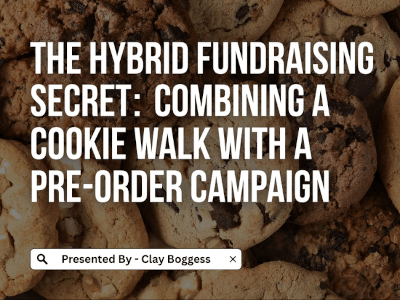
Learn essential strategies that will take your next fundraising event to another level.
Let’s open with a question that was posed in a recent article on this very blog:
Do you wonder if all the hard work in a fundraising event is worth it?
It’s a relevant question. Fundraising events can run the gamut from affordable to costly, low-key to grandiose, small to gigantic, and so on.
As this article advises, nonprofits need to consider two key areas:
- Budget
- Event planning
We’re going to focus on the latter to further that conversation.
We will zero in on a particular area: strategies to encourage your loyal advocates to donate.
The relationship between being an advocate and a donor is fluid. Many of your donors are sure to be active advocates and vice versa. But, you’re likely to have a group of people who tend to show support for your cause through advocacy strictly.
Instead, they help by “publicly recommending or supporting” your work (Learn more about the semantics here: https://www.salsalabs.com/amazing-advocacy-guide).
Their support is precious, action-oriented, and mission-driven but not necessarily financial.
With the proper techniques, you can do a better job of encouraging your advocates to become donors. And events are a great place to start!
In case you want to skip ahead to a particular section, here are the five strategies:
- Include an auction or a raffle in your next advocacy gathering.
- Mention donation opportunities in your communications.
- Offer chances for mobile giving.
- Make sure to research your advocates ahead of time.
- Emphasize the impact of a gift.
Explore all five ideas for converting advocates into donors during your next event!
1. Include an auction or a raffle in your next advocacy gathering.
Just like there are fundraising events, there are advocacy events. They have slightly different priorities, feeding into your end goal — serving your mission.
Famous examples of advocacy events include:
- Hand-delivering a petition to its recipient.
- Organizing a rally.
- Sending out a team to gather signatures.
- Peacefully protesting.
- Hosting a community event to raise cause awareness.
- Plus, many more!
The advice in this strategy is pretty straightforward: include an auction or a raffle in your next advocacy gathering.
Of course, not all advocacy events will be conducive to this (like hand-delivering a petition). Still, there are some that an auction or a raffle could complement nicely (like a night dedicated to raising cause awareness).
Auctions and raffles are a great way to convert advocates to donors because they are a fun and incentivized means of giving.
Instead of feeling like you’re approaching your hard-working advocates and asking them to donate on top of their service, you’re giving them a chance to win a fun prize or purchase a unique experience.
Plus, who doesn’t love a good bidding war? Auctions and raffles can be the perfect point of entry for new donors.
2. Mention donation opportunities in your communications.
Breaking news! You can’t secure donations that you don’t ask for.
Sure, the occasional donor might give out of the blue, but more often than not, supporters donate as a direct result of the hard work of your marketing and fundraising teams.
Just as you wouldn’t expect a random prospect to give without prompting, you can’t expect your advocates to do so.
Instead, incorporate donation information into the communications that you send out about your events.
You can add a small blurb or even just a “Donate Now” button to various pieces of correspondence, such as:
- Invitations of all kinds.
- Email reminders.
- Social media posts with event details.
- Acknowledgments.
- And any other correspondence you send out.
Just remember, if you’re directing your advocates to your online donation process, it needs to be in tip-top shape.
The better your online donation forms are, the more likely your advocates will complete the process.
We don’t want any abandoned online shopping carts!
The strategies for improving online donation forms are vast. For example, with advocates and events in mind, your team is going to want to optimize the page by:
- Keeping the form simple: The event brought your advocate to this page in the first place. They’re already a step away from where they planned to be; don’t overcomplicate the process.
- Suggesting giving levels: Keep the same simplicity principle in mind and account for the fact that some of your page visitors will be first-time donors. Offering giving levels makes things easier for all involved.
- Making the gift shareable: Most of your advocates are likely also some of your biggest supporters on social media. Encourage them to share their gifts on social networks to raise awareness and reach more people.
Those three techniques should give you an idea of what we mean by saying “optimize for advocates.”
Every donation page has an area that needs improvement. These improvements, in particular, impact your advocate-to-donor conversion rates directly.
Once you are confident that your donation forms are optimized, prioritize their promotion.
So next time you send your advocates an event-related communication, make sure it mentions donation opportunities!
3. Offer mobile giving opportunities.
Make donating at the event as quick and seamless as possible by providing mobile giving opportunities.
Did you know that 84% of event fundraising pledges are fulfilled? That’s too good of an opportunity to pass up!
Once you have mobile giving set up, promoting it during an advocacy event will be no problem.
Besides including mentions in your communications and on signs at the event, you can reserve a few minutes for one of your team members to have the floor. During that time, have the team member suggest that everyone take out their phone and donate.
Mobile giving has rapidly grown in popularity for a reason. Most people, from grandmas to middle schoolers, have smartphones. You can’t beat that level of accessibility.
Before your event, you’ll want to consider what aspect of mobile giving you will offer your advocates.
You might want to ensure that your online donation page is mobile responsive so that advocates can use their smartphones to go right to your website when you ask them to give. Or, you might want to look into services that provide text-to-give software.
Think through which solution will best suit both your event and your advocates.
Remember, a mobile-responsive website will benefit your organization with broad-reaching effects beyond advocacy events. It’s a worthwhile endeavor.
4. Make sure to research your advocates ahead of time.
Prospect research is likely already a big part of your general fundraising and event strategies. There’s no reason why you can’t refocus your research microscope on your advocates.
The more you learn about your advocates, the better your chance of securing a gift from them.
In particular, prospect research will be a massive help in finding advocates who are qualified candidates for major giving.
Thanks to a combined analysis of wealth and philanthropic markers, you should be able to determine who on your list of advocates has the potential to give a significant gift.
Your analysis will involve studying traits and behaviors that showcase an advocate’s philanthropic history and financial capacity. Such traits and behaviors include:
- Past giving to your organization.
- Involvement in other nonprofits.
- Owning sizeable real estate holdings.
- Considerable stock ownership.
- Donating to political campaigns
- And more!
When searching for significant gift prospects among your advocates, focus on philanthropy first and then qualify with wealth.
Just because someone is the wealthiest in your community does not mean that person will be open to donating.
While on the other hand, you might find an advocate with a solid drive to give and a less flexible financial situation. That person’s charitable instinct might mean they’re willing to give a more significant gift than your assessment of their financial situation would indicate.
Learn more about the great big world of significant gifts here.
5. Emphasize the impact of a gift.
We will close this list with a general fundraising tip to help convert advocates into donors.
It never hurts to focus on what good a gift can do.
When asking for donations, you already have a leg up with your advocates: they are devoted to your cause.
Advocates want to see your work succeed. So, on a fundamental level, they will be invested in doing what they can to make a difference. And sometimes, that can mean donating.
At your next advocacy gathering, whether it is a rally or petition delivery, make sure that your gift solicitation focuses on the potential impact of a gift.
Appeal to your supporters in a logical way. Explain what their donations will equate to in as much detail as possible.
—————————————————
With the right strategies in place, everyone wins. Your organization keeps an advocate and gains a donor. And your advocates experience new ways of connecting with your organization.
What about you? What are your strategies for turning advocates into donors? How do events factor into your planning?
Guest Author Bio
Dan Quirk is the Marketing Manager at Salsa Labs, the premier fundraising software company for growth-focused nonprofits. Dan's marketing focus is on content creation, conversion optimization and modern marketing technology helps him coach nonprofit development teams on digital fundraising best practices.



